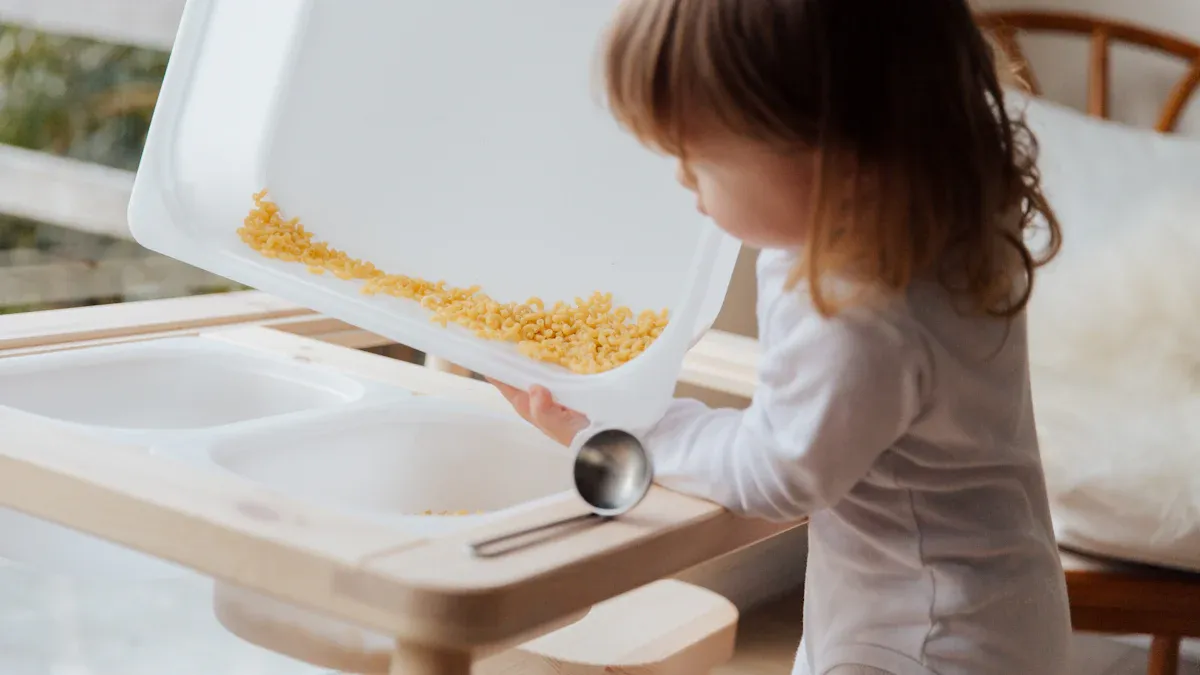Real Stories of Sensory Play Transforming Preschool Classrooms

You enter a preschool classroom and see kids laughing as they engage in sensory play activities for preschoolers, squeezing colorful dough in their hands. The room feels full of energy. Sensory play makes kids curious and helps each child show their best self. Many teachers and parents talk about these moments. Research says sensory play activities for preschoolers need more focus. Most studies look at trauma-informed practices instead and do not examine sensory-based ones as much. You may wonder what real change looks like. It happens when kids explore, touch, and make things together through these sensory play activities.
Key Takeaways
Sensory play helps kids build social skills. It teaches them to share and take turns. Kids also learn to talk with others in groups.
When kids do sensory play, they use new words. They talk about what they feel and see. This helps them get better at language.
Sensory activities make the classroom calm. They help kids control their feelings. Kids have fewer outbursts when they feel stressed.
Sensory play lets all kids join in, no matter their abilities. It helps everyone learn together. Kids feel more confident and independent.
Doing sensory play often helps kids explore and find new things. They learn to solve problems. Kids also start to love learning.
Real-Life Sensory Stories

Social Skills
Think about walking into a preschool room. You see kids around a big sensory bin with rice, scoops, and small animal toys. Each child waits for their turn. They share the tools and talk about what they find. These moments help kids practice social skills in a simple way. When you set up sensory play activities for preschoolers, you give them chances to learn about teamwork and friendship.
Shared sensory bins and group play help kids take turns, share, and talk with each other. These are important social skills.
Kids learn to listen and solve problems together. They decide who gets the blue scoop or how to build a sandcastle as a group.
Sensory play gives kids a safe place to show their feelings and connect with friends.
You might see that planned sensory play leads to better interactions. Kids who have trouble with social skills often join in more easily when the activity is hands-on and open-ended. This way supports good teaching and helps every child feel included.
Language Growth
You may wonder how sensory play activities for preschoolers help language grow. Imagine a child pressing hands into shaving cream, laughing as they draw shapes and letters. Another child says it feels "squishy" or "cold." These moments help kids use new words and talk more.
Evidence Description | Implication |
|---|---|
The study compares sensory processing skills of children with developmental language disorder (DLD) to typically developing children. | Highlights the impact of sensory processing on language development. |
Evaluates language skills alongside sensory processing to develop effective intervention strategies. | Suggests that sensory play can enhance language skills through targeted interventions. |
Emphasizes the importance of promoting development in all domains, including language therapy and sensory processing. | Indicates that sensory play may yield greater advantages in learning and development for preschoolers. |
You see kids using lots of sensory words. They talk about how things feel, look, and move. This helps them explain their feelings and what they see. Sensory play also helps with social skills and handling emotions, which are important for talking with others. When kids use sensory materials, they connect thinking and language. This helps them understand and share their feelings, making learning matter more.
Emotional Regulation
Some days, you see a child who feels upset by loud sounds or changes. Sensory play activities for preschoolers can help them feel calm. For example, a quiet spot with soft fabric, water beads, or sand lets kids explore slowly. You see them relax, breathe, and watch their hands move.
Sensory play is very helpful for kids with sensory processing disorders. It gives them a safe place to explore and learn to handle their feelings.
Doing sensory activities can lower emotional outbursts by 37% during tough times.
You watch as kids learn to handle big feelings with sensory play. They squeeze playdough when mad or swirl fingers in water to calm down. These activities support good teaching and help kids learn skills for handling emotions.
Inclusion
You want every child to feel welcome and important in your class. Sensory play activities for preschoolers make this possible. Kids with different abilities can join, explore, and learn together. You see a child with fine motor challenges pouring water from one cup to another, smiling proudly. Another child strings beads, getting better at hand-eye coordination and focus.
Activity | Skill Developed | Classroom Impact |
|---|---|---|
Manipulating playdough | Fine motor skills | All children can participate and succeed |
Pouring exercises | Hand-eye coordination | Builds confidence and independence |
Lacing beads | Precision and accuracy | Encourages focus and patience |
Group play | Social skills |
Teachers help make inclusion work. You watch, guide, and cheer for each child, making sure everyone gets a chance to shine. In Montessori classrooms, sensorial activities like color tablets and sound cylinders help kids build sensory skills. Life skills like spooning beans or sweeping help kids become independent and focused. Playing together with blocks brings kids closer and builds friendships.
Tip: When you make a caring space with sensory play, you help every child do their best. Good teaching means changing activities so all kids can join and grow.
You see the power of sensory play in every smile, every new word, and every kind act. These real stories show how sensory play activities for preschoolers change learning, fun, and inclusion in your classroom.
Sensory Play Activities for Preschoolers

Getting Started
You want to add sensory play to your classroom. You might not know where to start. Begin with easy steps. Collect things like rice, sand, or pieces of fabric. Put them in a shallow bin so kids can reach them. Choose a theme that fits the season or what you are teaching. Add scoops, cups, or small toys to make play more fun. Watch the kids as they play to keep them safe. Change the materials often so kids stay interested. Ask kids to use words like “soft,” “bumpy,” or “cold” when they play. Add movement by letting kids balance or jump. Let each child explore in their own way and at their own speed.
Tip: Let kids help clean up after playing. This teaches them to be responsible and makes sensory play part of their daily routine.
Adapting for Needs
Each child learns in their own way. You can change sensory play to help everyone. Some kids feel better with deep pressure. Give them weighted blankets or firm hugs. Some kids need a quiet place to calm down. Make a cozy box with pillows for them. Use headphones or special toys for kids who get overwhelmed. Playing together helps kids learn to work with others. Try water play in small groups to help kids talk and share. Change activities to fit each child’s needs. This helps them feel more confident.
Family Involvement
Families are important for sensory learning. You can send home easy sensory activities. Try water play or crafts with things kids can touch. When parents join in, kids learn to share feelings and talk to others. Some families make quiet spaces at home with soft lights and calm corners. Special sensory diets help kids feel safe and calm. When teachers and families work together, kids learn at home and at school.
Role of Families in Sensory Play | Description |
|---|---|
Personalized Sensory Diets | Families make special sensory diets to help kids stay calm. |
Sensory-Friendly Environments | Families set up spaces that fit each child’s needs and help them feel good. |
Active Engagement | Parents join in sensory activities to help kids grow and feel happy. |
Overcoming Challenges
Sensory play can be hard sometimes. Some kids get overwhelmed or have trouble paying attention. Make quiet areas and keep the room tidy to help kids focus. Teach kids to breathe slowly or imagine calm places to help them relax. The DIR/Floortime approach helps you meet kids where they are and build on what they can do. Calming activities like swinging or jumping help kids feel better. Work with occupational therapists to make a sensory diet for each child. With time and new ideas, you can make sensory play a good part of every child’s day.
Sensory Play Benefits
Exploration and Discovery
You see children light up when they get to explore new things. Sensory play gives them a chance to use their hands, eyes, and ears to learn about the world. When you set out a bin of rice or water, kids dig in and start asking questions. They notice how things feel, sound, and move. This kind of play helps their brains grow strong. Every time they scoop, pour, or sort, they build new brain pathways. Research shows that more than one million new neural connections form every second in early childhood. Sensory activities help children remember what they learn and solve problems on their own. You watch as they test ideas, try new things, and discover how the world works. Sensory play makes learning fun and helps kids become curious explorers.
Tip: Let kids lead the way during sensory activities. Their questions and discoveries make learning stick.
Communication and Expression
You want kids to share their thoughts and feelings. Sensory play opens the door for this. When children touch, smell, or listen to new things, they start to talk about what they notice. They use words like “sticky,” “smooth,” or “cold.” You hear them ask for more, describe what they see, and even tell stories about their play. This helps them grow their vocabulary and learn how to express themselves. Play is a child’s first language. It lets them show feelings that words cannot always explain. You see children act out stories with toys or dolls, showing happiness, sadness, or even anger. These moments help them connect with others and build strong social skills.
They follow directions and ask questions.
Play helps them understand big ideas like “full” and “empty.”
Adaptation Skills
You notice that every child learns in their own way. Sensory play helps them adapt to new places and routines. When you give them different textures or sounds, they learn to handle change. They practice problem-solving by figuring out how to build a tower or pour water without spilling. Sensory activities also help with fine motor skills, like squeezing and grasping, which are important for writing. Kids learn to work with others, take turns, and share ideas. They also find ways to calm down when they feel upset. This helps them focus and feel safe in new situations.
Description | |
|---|---|
Fine Motor Skills | Squeezing and grasping build hand muscles for writing and cutting. |
Language Skills | New words and simple instructions boost vocabulary and communication. |
Cognitive Skills | Kids solve problems and learn about cause and effect. |
Social Skills | Play encourages teamwork and empathy. |
Emotional Regulation | Sensory toys help children calm down and focus. |
You see children grow more confident and ready for anything. Sensory play gives them the tools they need for learning, friendship, and life.
You have watched sensory play make a big difference in preschool classrooms. Kids get better at social skills and handling emotions through these activities. The table below lists the main lessons from real stories:
Key Takeaway | Explanation |
|---|---|
Brain Growth | Sensory play helps kids focus, work alone, and learn new things. |
Emotional Well-being | Being in nature every day helps kids feel calm and safe. |
Social Skills | Playing with friends during sensory play helps kids talk and learn together. |
Try using sensory play in your own classroom or home. You can give kids different places to sit, set up quiet spots, and talk with families about ideas. Many parents and teachers tell great stories about how play helps kids learn. What you do is important. Share your own sensory play stories to help others find new ways to help kids learn.
FAQ
What is sensory play?
Sensory play lets you explore the world using touch, smell, sight, sound, or taste. You can use simple items like sand, water, or dough. This type of play helps your brain grow and makes learning fun.
How often should I include sensory play in my classroom?
Try to add sensory play every day. Even short sessions help children focus and relax. You can use different materials each week to keep things fresh and exciting for everyone.
Can sensory play help children with special needs?
Yes! Sensory play supports all children, including those with special needs. You can adapt activities to fit each child. This helps everyone join in, learn new skills, and feel included.
What if a child does not want to join sensory play?
Some children need time to feel comfortable. You can offer choices and let them watch first. Invite them to join when they feel ready. Never force play. Respect their pace and comfort.
How can families support sensory play at home?
Families can set up simple sensory play with items like rice, beans, or water. You can encourage children to talk about what they feel and see. This helps build language and makes play a special time together.
See Also
Essential Sensory Play Ideas for Early Childhood Teachers
Innovative Strategies to Enhance Learning Using Sensory Mats
Easy Ways to Create Sensory-Friendly Classrooms for Teachers
